
Should a city focus on big, high-profile facilities or should they focus on building a network of safe, low-stress connector streets and trails if they want to make riding a bike safer and easier?
It’s a chicken-or-egg sort of conversation I got into with Shane MacRhodes, Program Manager of Eugene Safe Routes to School, while we were riding around Eugene with Bob Passaro, publisher of Eugene Bicyclist.
Our conclusion was that one can’t exist without the other if either are going to live up to their full potential.
For example, take a look at where the Fanno Creek Trail crosses Hall Boulevard.
The Fanno Creek Trail is a convenient route that many people can use to transport themselves around Washington County. When the trail reaches Hall Boulevard anyone who wants to get across has to go well out of their way to find a safe, marked crossing.
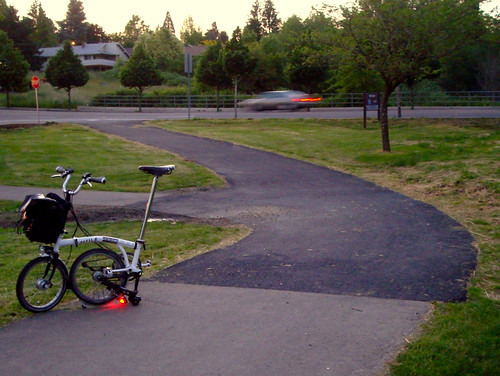
The result is that the Fanno Creek Trail near Hall Boulevard gets less use than other sections of the trail that don’t come to a dead stop.
Another example, this one of a large facility without safe connecting routes, is the bicycle and pedestrian bridge over I-5 near Kruse Way and Highway 217.

You probably have driven under this bridge, located over I-5 about 10 miles south of downtown Portland, but you may not have noticed it. That’s partly because the getting to either side of the bridge can be unsafe and the bridge is nearly impossible to find.
Here’s the cross walk on the west end of the bridge…

And here’s the sidewalk leading up to the east end of the bridge…
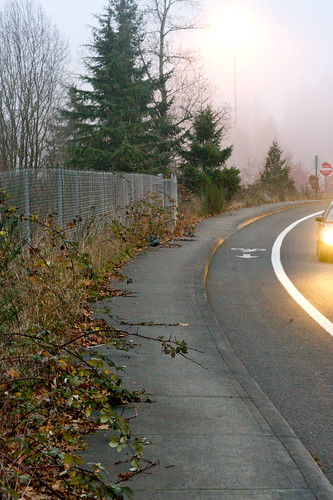
Accessing the Kruse Way bridge is unpleasant, at best. The condition of crosswalks and sidewalks leading to the bridge may prevent some people, especially those with mobility limitations, from accessing the bridge at all.
Building a safe transportation network and a big facility that work together make both more than a sum of their parts. The Hawthorne Bridge in Portland and the DeFazio Bridge in Eugene are examples where that combination has proved successful and people have responded by coming out on their bicycles in droves.
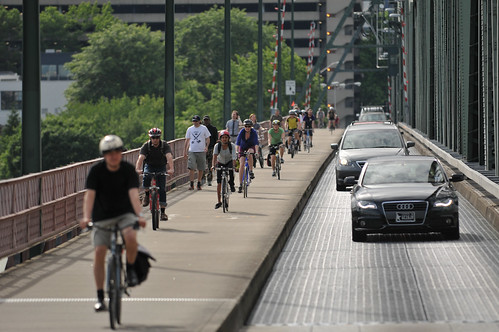
(Photo © J. Maus/BikePortland)
In order to get the most out of every scarce dollar we spend on transportation, planners must “think big” when it comes to barriers like freeways and rivers but they also must make sure there are safe, comfortable connections to their big ideas.


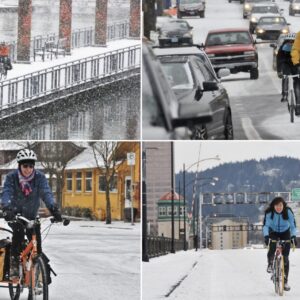
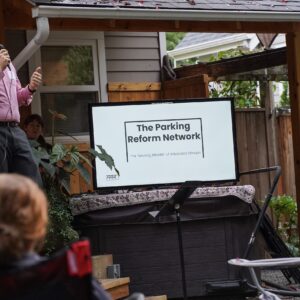
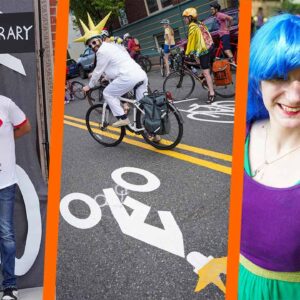
Discontinuous bike infrastructure is not helpful, but this is a dynamic problem, too. As cars cease to be the overwhelmingly dominant mode of transport everything will change for bikes too.
How can we incentivize PBOT and ODOT employees to go carfree, even if only for a couple of months?
Great topic, Will. And you are right, I did not even know about that bike/ped bridge near Kruse Way and Hwy217.
We must build greenways and bridges TOGETHER in a systematic way. –I again refer back to the Eisenhower era when we built freeways in this country on a massive scale. We can’t build just the bridges, or just the pathways leading to or from them. We need to follow a prioritized, systematic plan to establish our Active Transportation Network.
I’d argue that the western approach to the Hawthorne Bridge from downtown is pretty crap – the road is in bad shape, the bike lane crosses a right-turn lane for automobiles and there are buses pulling in and out across the bike lane, then you have to zig-zag up onto the path, hoping that automobiles coming up from Naito will stop behind the stop line, or they block your entry to the path.
That being said, I agree with the premise of the article, that those two things are really tied together, and that if you build a world-class bridge, but the streets that get you to the bridge are intimidating or un-passable, nobody is going to use the bridge, and if you make world-class bike routes that end before they go anywhere useful, again, nobody will use them.
apples and oranges to compare a redundant bridge at a car-centric freeway interchange with a city roadway bridge connecting high-density down-town…
the only reason to take that Kruse Way bridge is if you’re going east… otherwise the road is way more inviting and easy to access going west…
The photo illustrates a common problem in that area – blackberries encroach on the overpasses and ODOT does not keep up with them. I have added a very small pair of pruning clippers to my bike commuting gear and used them several times crossing 217 on 72nd southbound. Someone else did the same thing where Barbur crosses I-5 eastbound.
I have to catch blackberries earlier than those in the photo, though, as the clippers are not strong enough to cut older canes. I am pushing around 70 pounds of bike and gear when commuting as it is.
Will, how about a link to a map to show where that I5 bridge is?
found the link.. My bad. Sorry